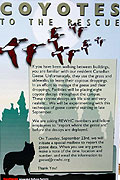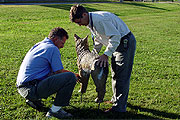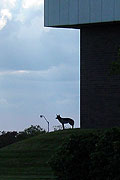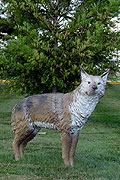 Beth Assembles
Beth Assembles
a Coyote
© 2003, W. Saslow
 Coyotes to the Rescue
Coyotes to the Rescue
© 2003, W. Saslow
 Coyote Lobby Display
Coyote Lobby Display
© 2003, W. Saslow
|
Coyotes on Patrol Project
If you walk between buildings on our campus, you are familiar with our resident Canadian Geese. Unfortunately, they use the grass and sidewalks to leave their copious droppings. In an effort to manage the geese and their droppings, REWHC placed 8 coyote decoys throughout the campus on 29 September 2003. These coyote decoys are life size and very realistic. REWHC members and fellow employees provide any goose sightings to a special email address.
What Brings Them Here
Located directly across the street from the Lawton Reservoir, our campus is a veritable "salad bar" for local and migrating Geese. Canadian Geese have a number of needs which we unwittingly have provided:
- Close Cut Grass - Geese need to get to tender grass shoots and can not waddle through tall grass.
- Open Areas - Geese need to have a nice open area to get plenty of warning of predators.
- Access to Water - The reservoir across the street fulfills this.
What They Do
The Geese, generally spend the night on the reservoir, then fly over to our campus for an all-day, all-you-can-eat, poop-where-you-will fest. Geese are known to produce 2-3 pounds of droppings a day. Multiply that by flocks in the hundreds, and the mess can be herific.
Our Approach
While we have allowed the grass to grow in some areas, corporate aesthetics calls for closely manicured lawns in other areas. Striking a balance of the aesthetic with wildlife management is our overall goal. We read in "Mass Wildlife" magazine an article about the use of decoys to take advantage of a natural predator of Geese, coyotes. We decided to procure a number of decoys, following the protocol:
- Prior to placement, collect data on quantities and locations of geese.
- Base placement on control of movement across traveled areas, not necessarily all property areas. If geese do not cross paths or roads, they won't make a mess there.
- Place decoys for maximum shadow at sunrise and sunset, and face towards reservoir wherever possible.
- Set up an e-mail address for sightings.
- Attempt to leave coyotes in place without moving them. If this loses effectiveness, go to a weekly rotation.
Results
Initial Data - Approximately 200 geese spotted throughout the campus on manicured lawns in zones 3 and 6.
1st Week (10/3/03) - Working Great! Geese are spotted circling in the air and moving on. A few geese are spotted late in week in the ball field, an area we left open to them.
2nd Week (10/10/03) - Still Working Great! - Seems to be working well. A few geese spotted in Zone 3, away from the Coyotes.
3rd Week (10/17/03) - No Birds Spotted! - Still see geese in the air, but they move on.
January 2004 - Up until Chrismas break, just a few geese here and there. After break, it appears that Geese are becoming densitized to the decoys. Perhaps the fact that the decoys have not been moved and the lack of people have allowed geese to become more inquisitive. Ground is frozen, difficult to move them now.
April 2004 - Most likely due to the lack of repositioning, the decoys are mostly ineffective for "local" geese. Others still fly over. To give the decoys a fair shot, they probably need to be repositioned weekly. More information once we've instituted a more frequent repositioning regimen.
|
|
Portsmouth, RI Location

Tom and Gregg
Install a Coyote
© 2003, W. Saslow

Coyote Sentinel
© 2003, W. Saslow

Coyote On Patrol
© 2003, W. Saslow

Coyote Positioned to Look Menacingly Towards Reservoir, Daring Geese to Land
© 2003, W. Saslow
|








